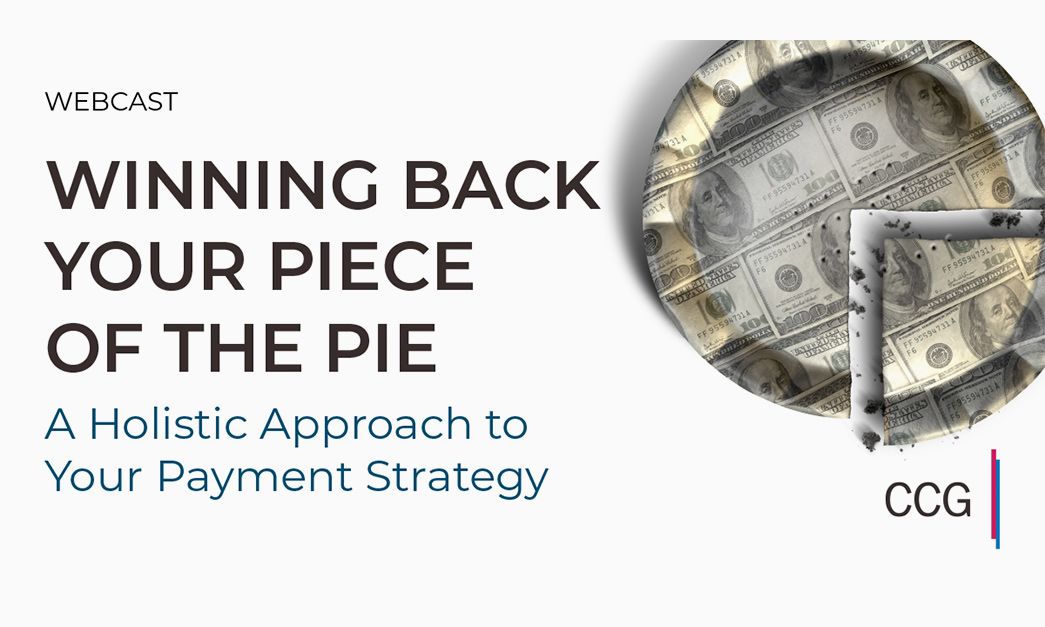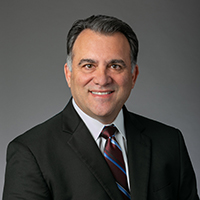Winning Back Your Piece of the Pie: A Holistic Approach to Your Payment Strategy
Available On Demand – 20 minutes
Join the CCG team for a 15 minute concise yet detailed overview with host Scarlett Sieber and financial services veteran John Macaluso discussing the importance of your payments strategy, how the payments landscape has evolved over recent years, and what you as a banking or credit union executive can do today to get back a bigger piece of the payments pie.
Subscribe to CCG Insights.
[restrict]
Scarlett Sieber Welcome back to CCG Catalyst’s webcast series. We are back for Episode 5 of our consumer banking series. As always, I am joined by my incredible colleague in John Macaluso, who is a Principal here at CCG Catalyst. I am Scarlett Sieber, your host, Managing director, Chief Strategy & Innovation Officer here at CCG Catalyst. We have come to you week after week talking about all things digital banking, focused on the consumer and we are back for week number five with another topic that we hope you are very excited about, which is really a holistic approach around your payment strategy. John Macaluso, my colleague Mac, loves payments, so I’m very excited to dive into this and Mac, thanks again for being here.
John Macaluso Great. Always good to be back, Scarlett. I think we have an exciting topic today to begin the conversation.
Scarlett Sieber Absolutely. So, before we get started, a few housekeeping notes. If you look at the bottom of the screen, you’ll see a variety of buttons. That middle screen is actually another picture of Mac and I’s face. If you click on that, you will see our bios on the left-hand side of your screen. You can connect with us on LinkedIn. We produce and show a ton of content on there. You can email us directly if you have any specific questions. To the right of that, you will see the CCG logo that is your go to resource for all things that you could care about. There is a ton of articles on there that Mac and I have coauthored in places like the Financial Brand, articles that our colleagues have written, and then there’s also links to other webcasts that you can have access to if you are interested in. To the left, you will see that Q&A button. That is your place to go throughout this entire episode. If you have questions, please go ahead and use that Q&A. Let us know, we will do our best to answer them during the webcast. If not, we will definitely get back to the same day and we would love to hear your ideas as well. So, it doesn’t always have to be a question, but it’s something that we say, sparks something that gets you excited, you want to push for something else? Let us know. We’d love to hear that. Housekeeping is out of the way. Let’s get going here. One of the things that I have not really mentioned, but I think I should add, is that we try to keep these around fifteen minutes. We know that you as banking, as credit union, executives and the fintech fans who are part of this as well and entrepreneurs, you are all super, super busy so we try to give you relevant, pertinent information in concise formats. So we try to keep it right around 15 minutes. And with that, I’m going to stop talking about this and get going. All right, Mac. So, payments, payments really encompass so much. Can you break down just really quickly, at a very high level, what are the primary types of payments?
John Macaluso I think you actually hit on the challenge of payments. There’s so many things we can talk about. So when I have these conversations, I like to break it down to four things. 1. It’s person to person, I can send you money, more importantly, you can send me money. 2. It’s person to business, we’re going to spend money. I’m going to buy a product or I’m going to buy a service. 3. There’s business to business, frankly, that’s when, one business pays another business for some type of activity or product or inventory. 4. Which is really kind of business to person. Things like refunds or cash back. That’s become a big issue. So we move money for four important reasons, person to person, person to business, business to business and business to person. And that’s the general, there’s probably some nuances in there, but for the purposes of this conversation, those are the important elements.
Scarlett Sieber That’s helpful. To begin, I’d let you know where we are going to go a little bit rudimentary to set the stage, and we will definitely dive a bit deeper at the end. So bear with us there. The other side of that, when you’re talking about payments, and thank you for that breakdown, Mac, is really around the rails. So when we think about the rails, what are they and what are the main rails on which money moves?
John Macaluso And the people that have heard me talk for years will kind of be chuckling right now when they hear that term rails, because it’s one that I use often. But the reality is there’s kind of five of them, they’re fundamental things. 1. Cash, cash is a rail, that exists. I can pay you cash. 2. Check, I could write you a check, you could write me a check. 3. ACH, which is a variation of electronic transaction that’s been there for years. 4. There’s debit and credit, which has been around for a long time, some people want to call that ISO. 5. Wires, and that’s important too.
Scarlett Sieber So when we think about the role that banks and credit unions play, how do they participate in this payment stream? And what are the primary usages for the banks?
John Macaluso Well, fundamentally, those rails, whether it’s cash or check or ACH or wires or debit and credit, those are driven by and owned by and paid for by banks and credit unions in the United States. So historically, banks have created and provided debit cards that attached to checking accounts. Many banks and credit unions have credit cards, which they either own the portfolio or they work with an affiliate on the portfolio. Every bank and credit union handles cash via at the teller line or via ATMs. Of course, ACH is one that they use in clearings and then wire transfers are all traditional ways that are how banks and credit unions support money movement. Now, the important aspect of this and why we’re kind of bringing this up in the conversation is that these very rails that are important to and used by consumers in many different ways, have historically been owned and managed by banks and credit unions. Unfortunately, they have evolved over time and an evolving over time, they have created operational silos within banks and credit unions. And the reality is, banks and credit unions aren’t viewing all of those capabilities as a single payment opportunity. How do I combine my debit card, my ACH, my check capability, into a single payment offering? And that’s really Scarlett what our conversation is about today, it’s how you look at those rails that we had been using in the banking and credit union industry for so long, that we have created, that are now operational silos, how do we look at those as one comprehensive platform? Because others are beginning to do that.
Scarlett Sieber So on the comment about the evolution of payments and how over recent years in a lot of ways banks and credit unions have been a bit disintermediated. Traditionally, they have provided the rails and provided the services. How has this changed at a high level? And then from your brain, why has this changed? What has caused this shift?
John Macaluso How it has changed is very interesting. OK, there’s two services out there that everybody talks about. Venmo, which is a huge service. In fact, in 2019, Venmo did over $100B in payments. The interesting part is Venmo utilizes two rails, ACH and the ISO or the debit card platform. The other platform that is gaining ground, and has actually overtaken Venmo, is Zelle. In 2019, Zelle did over $187B, in payments with 740M+ transactions and implemented over 600 banks and credit unions in the United States. Now you could say, hey John, that’s interesting, we’re using Zelle, we like Zelle, it’s part of our portfolio. However, the challenge for you is that the consumer does typically not view Zelle as a component of the banks capability. Rather, they view Zelle as its own product, that’s the customer experience. That’s where they’re gaining their value. That’s where they see it. So while Zelle and Venmo are very neat and consumers have really adopted them and it’s made a statement about our willingness to utilize mobile based platforms for money movement, banks and credit unions have absolutely steeded that ground to a third party. The other area to look at is person to business. Now, when you and I went to a restaurant and we bought dinner or we went to a department store and we bought a product, we would take out our debit card or our credit card and we would use that in that transaction would be branded by my bank or my credit union. I would view my financial institution as a very important part of that financial transaction. However, what’s happening today, and this is very important, it’s subtle and it’s significant at the same time, is that many retailers, medical providers, restaurant organizations, are all building mobile applications that are branded as the retailer where we embed our debit card or credit card information inside that application. So when the consumer pays their bill, when they move that transaction, instead of taking that debit card out or that credit card out that has the bank brand on it, they’re allowing that transaction to run via the mobile platform of the retailer or the medical organization or frankly, of the mobile phone provider and we all know who that is. The area of opportunity where clearly person to person and person to business, banks and credit unions need to kind of regain that land and we’ll talk about that in a minute. But the real area of opportunity is in business to business payments. Business to business payments have historically been based around check and wire payments and ACH is starting to make some headway in there. But we have been fearful of that because of the issues with risk and fraud and settlement and the timing of that. But we as a financial industry, banks and credit unions specifically, need to look at that. That’s our opportunity. That is clearly not an area where we want to give ground to a third party to establish that. And I will tell you, there are third parties that are focusing around business to business transactions. There are answers to those problems but it’s going to require some creative thinking on our part. And then fundamentally, business to person and business to person is a real opportunity for us, because once again, you know, when you have the consumer involved, the consumer is going to make an assumption that they can be paid by Venmo, they can be paid by Zelle. Therefore, a bank needs to wedge themself into that, a credit union needs to became part of that chain so that the consumer understands that. So that is what has changed in our industry. Third parties have taken the rails that we established, that we paid for, we invested in, that we built operations around, and integrated them into mobile experiences, which absolutely disintermediate the banks. It makes us look less significant in the overall financial picture of a consumer.
Scarlett Sieber When you mentioned the comment around experience, I think that’s absolutely key. If we go back to where you started with this with the P2P and we look at someone like Venmo and you talked about the kind of volume with Zelle which has now surpassed Venmo, I’m sure if we look at the demographic breakdown, we’ll see younger people still probably gravitating toward someone like a Venmo. But really it’s about the experience. They don’t associate that with banks on the back end connecting or whatever else, they say, hey, I’m with my friends we are out doing things, I want to get an immediate payment. I’m going to go get my nails done at the salon around the corner, they would rather you use Zelle over a credit card. And, you know, you can have fun emojis in there. So it really goes back, in each of those cases, of course, we’re talking consumer here, but in every case that you presented, there really is that experience component. And the end user is caring a lot less about what’s happening on the back end and more about how it feels for them. How easy, how simple, how beautiful, and what capabilities they have. So I think that’s certainly important to make sure that while we as the financial institutions spent so much time building out that the plumbing and piping, so to speak, that we actually take credit for that and really come back and own that. So, I think I mentioned in the beginning, this is really about the holistic approach to payments and getting the piece of the pie. So let’s stop here for this first episode with this question. What can banks and credit unions do to get back a bigger piece of that pie?
John Macaluso So that’s the most important question that we’ve talked about all day, and this is our opportunity. But there’s a couple of things I’ll leave you with to answer your question. Number one, we need to look at our investments in the people and the processes and the technology that manage these rails and we need to understand them. They are so embedded in bank and credit union operations today that frankly, I’m not sure we understand what our true cost of those are therefore what our true opportunity is. Number two, we need to look at how we embed payment activity and payment programs into our mobile apps. We have spent a fortune building mobile apps. We need to spend the time, get creative thinking about how we can be that platform that people use at that point of purchase. And then finally, we need to think about the business part. Financially, the most lucrative part of all of this for banks and credit unions is looking at how we can support banks and that’s a whole another conversation that I think we ought to have. Whether you create a closed loop networks or we utilize money movement within platforms and within systems, whether we begin to look at how we manage better settlement across banks. Understanding and resolving the opportunity for business to business payments is significant for banks and I’m looking forward to the next conversation on this.
Scarlett Sieber Absolutely, and we’ll dive deeper there. Quickly before we go, we’re right around 15 minutes. But I do want to get one question answered here. So this this comes from Scott. As a smaller financial institution, do you see we have the same ability to compete with the top five banks?
John Macaluso Thank you, Scott. That’s a good question. So I do believe that technologically, we do have the ability to compete with the larger financial organizations. I will also tell you that I think it’s more of an imperative for banks and credit unions to be very good at this or very quickly we will lose ground. But yes, I do think we have the capability to do that. I’ve seen some amazing things that are done in our industry. We just have to make them more common.
Scarlett Sieber Perfect. Well, thanks for that question, Scott. For anyone else who has those questions, please go ahead. Keep them coming and we will respond to you and chat if we can. If not, we’ll get back to you by the end of the day right after this session. Mac, as always, thank you for taking the time. This was another engaging session for me. Payments is definitely something that I care a lot about. I’m looking forward to our next level where we get into a bit more granular detail, we wanted to keep this one a high level to get people excited and started. Join us next time as we go to the next level and there’s a lot that we can explore within payments. We will have that link for you included as well. So you can go ahead and click the link below to see what the next session looks like. As always, give us your questions, give us your feedback. If there are things that you definitely want to talk about, let us know. If there are questions you have around payments you want us to come and think about a payments strategy with you, let us know. We are looking forward to next time. Until then, stay safe and enjoy the rest of your day.
John Macaluso Thanks. Talk soon.
[/restrict]
Over the COVID Horizon, Mobile Banking Demands Strategic Clarity
Business Continuity: Unlocking Digital Commercial Banking Capabilities
Financial Brand Article: Is It Finally Time for Open Banking’s Debut in America?
Chief Strategy & Innovation Officer Scarlett Sieber is one of the world’s premier voices in financial services. She is among the industry’s most sought-after speakers as a thought leader and innovator with expertise in driving organizational change at both startups and enterprises across the financial services and fintech ecosystem. Scarlett has been invited to speak at over 100 prestigious financial services and technology conferences globally, including Money20/20, Finovate, South Summit, and NASA’s Cross Industry Innovation Summit.
Scarlett’s experience includes founding her own startup as well as working at banks such as BBVA, USAA, and Opus Bank. She is a leading fintech influencer, included on lists such as Top 100 Women in Fintech 2019 and Top 10 Fintech Influencers in the U.S. Scarlett also has deep experience in digital strategy and innovation implementation, making her a key asset to building cutting-edge programs for our clients.
As Principal of our Technology Strategy, John Macaluso has built a reputation within financial services as a trusted advisor to banks and fintechs. With over 30 years of proven leadership, John’s experiences include all areas of information technology, business planning, innovative solution design & deployment, business & operational leadership and business & technology transformation. John advises a vast area of technology within financial services from fintech startups to established global financial institutions. Specialties include digital transformation to established core technologies.
Previously, John held senior roles at Fiserv (a fortune 500 company) driving large-scale change from multi-channel to traditional and non-traditional banking services, national to international markets. Additionally, he served as a CIO for the MLB New York Yankees diving innovation and technology to major league baseball.








